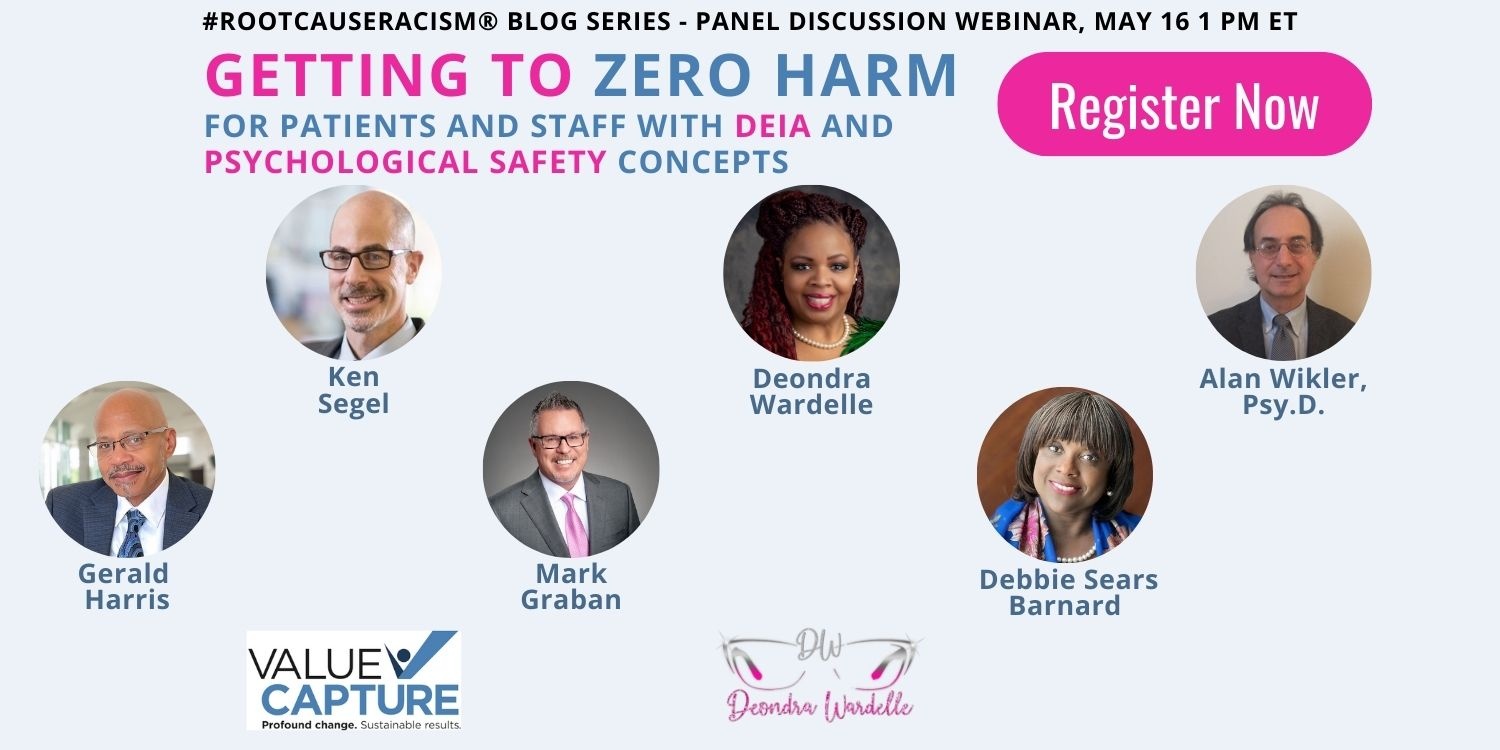The fourth blog post in the #RootCauseRacism series.
Adverse events during hospitalization are a major cause of patient harm. A 1999 publication by the Institute of Medicine (IOM), estimated that between 44,000 and 90,000 Americans die each year as a result of medical errors. Adverse events, such as infections, falls, and medication errors, occurred in 2.9 to 3.7 percent of hospitalizations. Over half of these events were judged to be preventable. They are overwhelmingly caused by poor processes that do not protect against human error, as opposed to incompetent or malevolent healthcare workers.
A new study published in the New England Journal of Medicine (2023) found that, despite considerable attention to and resources allocated to patient safety, results are not much better today. Adverse events were identified in nearly one in four admissions, and approximately one-fourth of the events were preventable.
Disparities are Seen in Health Outcomes and Safety
The safety of healthcare in the United States is measurably worse for minorities. Patients from ethnic minority backgrounds may experience disparities in the quality and safety of healthcare they receive, particularly African Americans who have higher rates of hospital-acquired infections, and adverse drug events.
Women and people of color are under-represented on hospital boards and among the medical staff. On average, healthcare boards are comprised of 87 percent white members and 13 percent people of color. Nearly three-fourths (72 percent) of the members are male, and only 3 percent are black women. In contrast, frontline medical staff tend to be disproportionately female and people of color, and are at the greatest risk of injury, particularly during a pandemic.
Healthcare disparities exist even before a patient steps foot into a doctor’s office or hospital. Those at the lower end of the socioeconomic spectrum have:
- less access to healthcare,
- are less able to afford preventive care and disease management,
- are often at greater risk for inadequate housing,
- less likely to have an intact family, as well as
- higher levels of drug abuse and domestic violence in the community and perhaps in the household.
These profound social determinants of health were described by Don Berwick, MD, the Institute of Healthcare Improvement (IHI) President Emeritus and former Administrator of the Centers for Medicare & Medicaid Services (CMS), in a 2018 keynote speech at the IHI’s Annual Forum. Using New York City’s subway map, Dr. Berwick highlighted how inequality affects health. On a D Train from the Upper East Side of Manhattan into the Bronx, the average annual household income shrinks from $180,000 to $45,000, and the unemployment rate doubles.
Harm and Mistakes are Caused by Process Problems, not Bad People
The harm that occurs to patients and staff alike in the process of receiving or rendering care in a healthcare organization is rarely the result of people acting on decisions to cause injury or death. Nor is it often the result of recklessness, as when a provider takes unjustified risks or comes to work under the influence of drugs or alcohol.
As the IOM reported in 1999, accidents and injuries happen overwhelmingly because “to err is human,” meaning that well-intentioned people make mistakes — as we all do. We are susceptible to lapses in attention, especially due to distraction and fatigue. We are forgetful, forgetting what we were taught to do, or we forget to do something we intended to do.
Healthcare settings are highly complex and are high risk for all involved, patients and staff alike, and the processes of delivering care should be designed to minimize or mitigate the risks of human error. Often (though not always), this is done through a series of checks and balances. For example, medication is ordered by a physician, then the medication and dosage are reviewed and checked by a pharmacist, and again checked by the nurse who gives it to the patient. The patient may be familiar with the medication, or, if it is new, should have been informed about it by the physician and/or the nurse. Thus the patient has the last opportunity to become aware of a medication error.
Despite all of these opportunities for a wrong drug or wrong dosage to be detected, it sometimes gets through all these barriers and a medical error occurs. Whether the error reaches or harms the patient or not, the person who catches the mistake would ideally report it to a supervisor or through the hospital's quality and safety reporting process, such as initiating a paper or electronic patient safety incident report. Most hospitals have a procedure for reporting such incidents, so that the cause can be identified and prevented in the future.
For hospital workers, the complexity of care that creates the risk of harm to them is in the constant movement of patients and movement of staff between patients. Patients are transported between the emergency department, their beds, the bathroom, imaging department, and other areas where diagnostic workups and treatment are performed. Hospital workers do a lot of lifting, pushing, and pulling, resulting in sprains, strains, pain — and occasionally more serious trauma injuries. The movement of hospital staff from room to room, plus the constant turnover of admitted and discharged patients requires that dirty bedding be removed and replaced by clean bedding, increasing the risk of hospital-acquired infections if this is not done properly.
Imploring People to “Speak Up” Hasn’t Worked - Why?
It is obvious that healthcare facilities are filled with dangers and the goal of “zero harm” that many hospitals aspire to is daunting. The people who visit, stay and work in hospitals are the ones who witness (and are often a party to) the risks day to day, as well as the close calls and actual injuries. Often, they see the risks, the accidents waiting to happen. Both staff and patients have been urged for decades to "Speak Up for Safety," although the data suggests that the impact of these campaigns has not been as strong as one would hope. Next, let’s explore why that is true.
Most healthcare professionals chose their profession to help others to prevent, manage and overcome disease and injury, so one might wonder why it is so hard to speak up.
The answer is that they are often afraid to speak up about safety concerns due to a culture of fear, fear of being fired, being labeled a troublemaker, or simply not being heard. Those at the bottom of the organizational and societal hierarchy have it worse, as they are more vulnerable than their upwardly mobile counterparts. Those with less education and skills valued less by employers often have fewer job opportunities, thus the fear of losing their job is more palpable for them. Being paid a lower wage may result in having less money saved up or invested (if any), being closer to food insecurity, not being able to afford medical bills or even housing. For anyone considering speaking up about a safety concern or error that has been made, a quick risk/benefit analysis comparing the perceived possible catastrophic consequences to oneself of immediate job jeopardy versus longer-term safety for others leads them to choose to remain silent to protect themselves.
Patients too are afraid to speak up about their care and safety, deferring to the expertise of highly educated physicians and other clinicians, and their high social status. They are also dependent on the staff to take care of their human needs, to be fed, medicated, get better and leave the hospital. Often, they need assistance with activities of daily living such as toileting, showering, brushing their teeth, shaving, and combing their hair. Thus to confront a caregiver or another staff member about a safety concern also results in an internal risk/benefit analysis in which the perceived immediate risk of alienating the people they are dependent on wins out - like staff, it’s understandable why they might choose to stay silent.
We Need to Feel Psychological Safety
When employees and patients are afraid to speak up and advocate for their needs and preferences, it is due to the social pressures within the healthcare system to keep silent, not personal weakness. To speak up in such a culture of fear puts them in a position of vulnerability.
Author Timothy R. Clark’s book, The 4 Stages of Psychological Safety, states that creating a culture of “psychological safety” is beneficial not only to the people involved, but is necessary for the organization to improve and innovate. It proceeds in four stages. In the context of healthcare, the four stages are:
Inclusion safety - People are treated with respect, and as equals. As employees, they can attend discussions and meetings that affect their jobs. As patients, they are given access to healthcare and informed about their health. Their needs and preferences are valued.
Learner safety - Patients feel safe asking questions about their health, are educated about conditions and treatments, and can discuss alternatives. Staff and trainees can make mistakes without punitive repercussions.
Contributor safety - Patients actively participate in their care through shared decision-making with their providers. Staff can safely participate in discussions and meetings with their peers, supervisors, managers, and leaders. At this stage, the needs of a diverse workforce (including race, economic background, gender identity, and sexual orientation) can be openly expressed.
Challenger safety - Patients can safely question health decisions being made for them and ask for changes to their treatment plans. They may request more conservative treatment, such as medication instead of surgery, or refuse treatments they feel are too risky. If a nurse tells them to take a pill that they do not recognize, or are told to take a medication for a condition that they don’t have, they can safely speak up and refuse to take it, or at least discuss the possibility that an error is about to be made. Both patients and staff can speak up about apparent unsafe conditions in the environment, such as tripping hazards or cluttered hallways. If the particular needs of women and minorities are currently not being met, they can be discussed and addressed without overt or covert punitive pushback.
Hospitals need to progress to the level of high challenger safety in order to decrease adverse events that harm patients and staff. Campaigns to encourage patients and staff to “speak up for safety” are more effective when all stakeholders feel safe to speak up about risks and errors and need not be concerned that doing so will result in them getting fired, ostracized, or treated poorly. They can inform others of what they know or think via established incident reporting processes without putting themselves in jeopardy. For the organization as a whole, high levels of challenger safety thus foster diverse ideas, forward thinking, innovation, and improvement.
How Can We Cultivate Psychological Safety?
Dr. Clark states that leaders can foster a culture of psychological safety through their behavior and the structure of communication in the organization.
For instance, when meeting with others, they can model acts of vulnerability and humility, such as saying, “I don’t know” or “I may be wrong.” when asked a question or making a suggestion. Not only does that give everyone else tacit approval to do the same, but more importantly, it dispels the notion that the leader is omniscient and perfect. None of us are, and we shouldn’t hold back for fear of the discovery of our imperfection.
In meetings, the leader typically sits at the head of the table and runs it. If he or she perhaps asks someone else to run the meeting and takes a seat among the other participants (ideally at a circular table), it communicates that everyone is equal in terms of participation, thus encouraging greater participation, contribution, and discussion. The leader can simply sit quietly and listen, communicating respect for the other participants. When speaking, the leader can invite others to challenge him or her, in a way that is both safe and respectful, saying, “Tell me why I might be wrong. Help me to see my blind spots,” and then thanking the challenger for doing so.
As healthcare leaders show respect for others in these ways, two things happen. First, staff are less guarded and lessen their fears of negative repercussions for speaking up or reporting dangers, thus psychological safety leads to physical safety. Secondly, they become more engaged in their work and workplace. Staff who are more engaged report greater job satisfaction and are less likely to leave.
There is a famous story about President John F. Kennedy’s first visit to NASA’s headquarters back in 1961. During his visit to the NASA space center, as the story goes, President Kennedy noticed a janitor carrying a broom. He interrupted his tour, walked over to the man and asked, “What are you doing?” “Well, Mr. President,” the janitor responded, “I’m helping to put a man on the moon.”
Whether the story is true or simply urban legend, it is often used to illustrate the power of employee engagement when they see their job connected to the mission and vision of the organization. Similarly, and especially during the Covid pandemic, housekeepers were aware of their key role in infection control -- some hospitals use language of “everybody is a caregiver.”
We Must Take Action
Returning now to diversity, equity, inclusion, and accessibility, it should be clear now that a low degree of psychological safety in a healthcare organization is a barrier to employees and patients being treated respectfully as equals, with valid needs, concerns, ideas, and opinions. The discussion of errors is discouraged and they often go unreported, resulting in missed opportunities to improve physical safety and reduce harm to staff and patients in the workplace. The resource of the divergent points of view, experiences, and ideas of the diverse workforce goes untapped, leaving the staff excluded, less engaged, and less satisfied. As a result, the organization stagnates without progressive ideas of the diverse workforce being discussed or implemented.
Healthcare organizations need to cultivate a culture of psychological safety to protect the physical safety of patients and staff. The transformation needs to start at the top, in the boardroom, C-suite, and top executive offices. Those in managerial positions or on DEIA boards or committees should assess the degree of psychological safety in the organization. Tools are available to measure it, for each of the four stages, and actions should be implemented to increase psychological safety. When the organization demonstrates higher psychological safety, more productive discussions and planning to increase DEIA through hiring and promotion can occur — resulting in better, and equitable, outcomes and safety for all.

Written by Alan Wikler, Psy.D. (he/him/his)
Alan Wikler Psy.D. is a Clinical Psychologist and lean practitioner with a deep interest in healthcare quality, safety and improvement. He worked at the VA New York Harbor System for 31 years, first as a clinician and administrator in their substance abuse program, then as the Deputy Performance Improvement Manager, during which time he earned a Black Belt in Lean Performance Improvement, then created and ran the hospital’s Systems Redesign and Improvement Program until his retirement in 2022. He currently writes about healthcare performance improvement and patient safety, focusing on Psychological Safety in Healthcare. Alan earned his Master of Arts (M.A) in Social Psychology at New York University and a Doctor of Psychology (Psy.D.) degree from Yeshiva University. He was a Clinical instructor in Psychiatry at New York University for over 25 years and an Adjunct Associate Professor of Health Policy and Management at the NYU Wagner Graduate School of Public Service, where he taught Continuous Performance Improvement for healthcare leaders. His hobbies include snorkeling, playing guitar, and astronomy.


Submit a comment